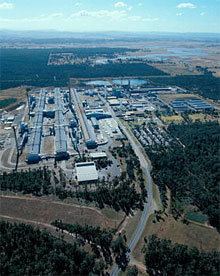Population 5,772 (2011 census) Postcode(s) 2327 Elevation 40 m | Established 1902 Time zone AEST (UTC+10) Area 5.1 km² Postal code 2327 | |
 | ||
Weather 29°C, Wind E at 16 km/h, 67% Humidity | ||
Kurri Kurri is a small town in the Hunter Region of New South Wales, Australia, in the Cessnock LGA. In the 2011 census its population was 5,772. Kurri Kurri is the largest town in a group of towns and hamlets, including Stanford Merthyr, Pelaw Main, Weston and Abermain, for which the ABS publishes population estimates. The estimated population of Kurri Kurri - Weston was 17,241 as at June 2014.
Contents
- Map of Kurri Kurri NSW 2327 Australia
- Foundation
- Coal mining
- Railways
- Local government
- Civic competitions
- Primary schools
- Secondary schools
- Tertiary campuses
- Local art
- Sport
- Notable people
- References
Map of Kurri Kurri NSW 2327, Australia
Kurri Kurri's name comes from the local Awabakal language where it has a meaning similar to "the beginning" or "the first".
The town's economy today is largely based on the surrounding wineries now that the aluminium smelter closed in 2012.
Foundation
Kurri Kurri was founded in 1902 to service the local Stanford Merthyr and Pelaw Main collieries and mining communities. The town was named by District Surveyor T. Smith who chose the name because he believed it meant 'hurry along' in a local dialect.
The Kurri Kurri Hotel (1904) is one of several built during the era of mining prosperity in the early 20th century. It is an impressive three-story building featuring prominent verandas with cast-iron lacework. The Empire Tavern was also built during this period. Kurri Kurri has numerous small miners' cottages from the same period.
Coal-mining
Mining at the South Maitland Coalfields began at East Greta in 1891, after an 1886 exploration by Sir Edgeworth David, a government geological surveyor, uncovered the potential of the Greta coal seam. More mines were opened in the early 1900s, supplanting those older pits at Newcastle where the Australian Agricultural Company enjoyed almost a monopoly. During this period there were a number of accidents including the death of six miners at the Stanford Merthyr Colliery in 1905, which is commemorated by a monument in the Kurri Kurri cemetery.
Richmond Main Colliery, also in the Kurri Kurri vicinity, was once the State's largest producer, at 3,400 tons per day, and which reputedly had the deepest shaft permitting access to two separate coal seams, the Scholey shaft, named after its founder, John Scholey. Following the serious slump in the coal industry Stanford Merthyr Colliery closed in 1957, Pelaw Main in 1962, and Richmond Main in 1967.
The power station at Richmond Main Colliery, which provided the electricity for Kurri Kurri and surrounding districts, remained in operation for some years after the mine's closure, until the entire district was attached to the National Grid.
Railways
Kurri Kurri was served by the South Maitland Railway and originally had two passenger stations – one at Stanford Merthyr, and one on the main SMR line at North Kurri Kurri (opened in June 1904). A new red-brick station building and platform was built at Stanford Merthyr and opened in January 1909. It was renamed Kurri Kurri Station on 3 June 1922. However, with the closure of the SMR's branch line from Aberdare Junction to Stanford Merthyr, due to subsidence, North Kurri Kurri station was renamed Kurri Kurri in the mid-1930s. The station at Stanford Merthyr fell into disuse although the line from the colliery which passed through it was still in operation via the Richmond Vale Railway to Hexham. While passenger services on the South Maitland Railway have ceased, the line is still in use for coal haulage. A new bridge is to be constructed to relocate the railway line to allow construction of the Hunter Expressway.
Local government
Until the creation of the local government area known as the City of Cessnock, Kurri Kurri was the centre of the Shire of Kearsley, which included most of the rural areas and villages around the township of Cessnock and part of the western suburbs of Maitland.
Civic competitions
In 1988 the town established a Tidy Town Committee under the stewardship of the Keep Australia Beautiful competition. The town achieved immediate success and in the space of 6 years took the best town in NSW in 1993 and was a finalist in the best town in Australia.
This was followed by the establishment of the Small Towns committee known as Towns with Heart.
Primary schools
Secondary schools
Tertiary campuses
Local art
It is now becoming internationally renowned for its murals with more than 55 murals painted around the town and its environs depicting the history of the region and also recent events. Each year the town also hosts a Nostalgia Festival featuring rock 'n' roll dancing, hot rod and bike shows.
Sport
Retired Newcastle Knights Rugby League player Andrew Johns spent his childhood in Kurri Kurri, before moving to Cessnock. He would later play in the Kurri Kurri Under-16's side, as Cessnock was unable to field a team. Kurri Kurri is also noted has having produced more Rugby League internationals than any other bush town in Australia.
Kurri Kurri is also home to the 320 m (350 yd) long Loxford Park Speedway, a motorcycle speedway. The speedway has hosted a round of the Australian Solo Speedway Championship every year since 2011 as well as hosting the Australian Sidecar Speedway Championship twice (2012, 2014), the Australian Under-21 Solo Championship on three occasions (2012, 2013, 2015), the Australian Under-16 Solo Championship in 2012, and the NSW Solo Championship each year since 2011. The speedway has also hosted rounds of the Sidecar Grand Slam series and also holds the Jason Crump invitational for solos annually on Boxing Day in honour of Australia's only triple Speedway World Champion. Loxford Park also includes a 135 m (148 yd) junior (under-16) track on its infield.
